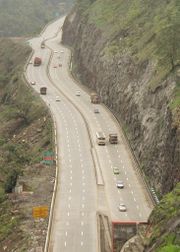What is the longest highway on the india?
By supunpw
@supunpw (574)
Sri Lanka
December 5, 2006 11:00pm CST
India is the class of roads maintained by the Central Government and is the main long-distance roadways. The National Highways, the majority 2 laned (one in each direction), constitute a total of about 58,000 km, of which 4,885 km are central-separated expressways. Highways in India are around 2% of the total road network in India, but carries nearly 40% of the total road traffic. The recently passed National Highways (Amendment) Bill, 1995, provides for private investment in the building and maintenance of these arteries of India. In the recent past, a number of new roads have been classified as NH's in a move to provide national connectivity to even remote places. In the recent past, a number of bypasses have been constructed for big and small towns and cities to provide uninterrupted passage for highway traffic. The varied climatic, demographic and traffic situation prevents these highways from having a uniform character. These may be six laned in some parts, to even non-metalled stretches in remote places. Many NH's are still under upgradation or even construction. There are long NH's to connect the metros together, as well as short shoots off the highway to give connectivity to the nearby ports or harbours. The longest NH is the NH7 which goes all the way from Varanasi in Uttar Pradesh to Kanyakumari at the southern most point of the Indian mainland, in Tamil Nadu covering a distance of 2369 km, and passing through the metros like Jabalpur, Nagpur, Hyderabad and Bangalore. The shortest NH is the NH47A, which is a 6 km stretch to the Ernakulam - Kochi Port.
The 95 km long Mumbai-Pune Expressway
Enlarge
The 95 km long Mumbai-Pune Expressway
India has a vast network of National Highways. India's highways connect all the major cities and state capitals. Most highways are 2 laned. In some more developed areas it may broaden to 4 lanes. Closer to big cities, highways can even be of 8 lanes. India has the distinction of having the world’s highest motorable highway connecting Shimla to Leh in Ladakh, Kashmir.
All the highways are metalled. In most developed states the roads are devoid of potholes, however in less developed states and in sparsely populated areas, highways are riddled with potholes. Very few of India's highways are concretised, the most notable being the Mumbai-Pune Expressway.
Highways form the economic backbone of the country. Highways have facilitated development along the route and many towns have sprung up along major highways. Highways are dotted with local restaurants or inns popularly known as Dhabas. They are known to serve delicious local cuisine and also serve as trucker stops.
Under the former Prime Minister Atal Behari Vajpayee, India launched a massive upgradation of highways called the Golden Quadrilateral Project where the main north-south and east-west connecting corridors between the 4 metropolitan cities were concretised into 4 lane highways. Work is scheduled to be completed in December 2006.
The golden Quadrilateral boasts of some breathtaking spots and some amazing flyovers.
Some of the Busy National Highway sectors in India have been converted to 6 or 4 lane Expressways. For example, Delhi-Agra, Delhi-Jaipur, Ahmedabad-Vadodara, Mumbai-Pune, Mumbai-Surat, Bangalore-Mysore, Bangalore-Chennai and Chennai-Tada. There is a bigger plan (NHDP Phase V) to convert all of the Golden Quadrilateral Highways (6000 km) to 6 lane Highways/Expressways) by 2012.
1 response






